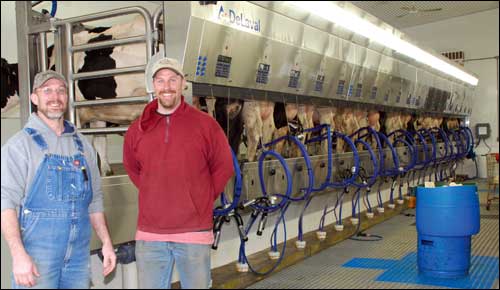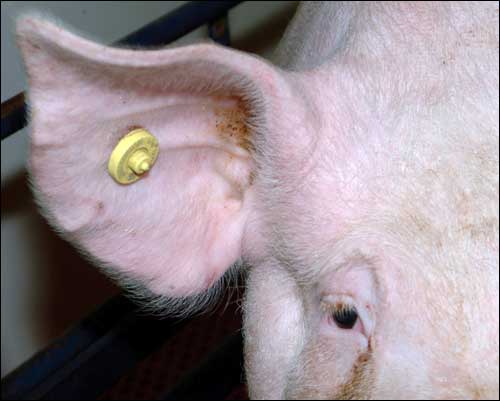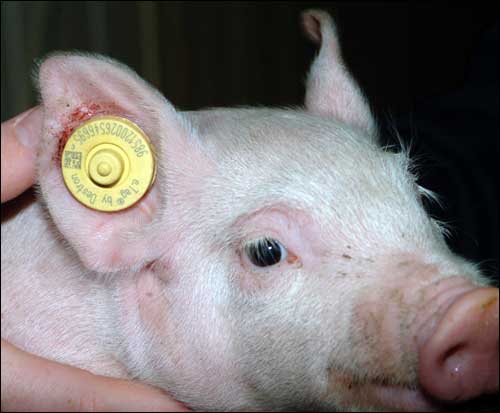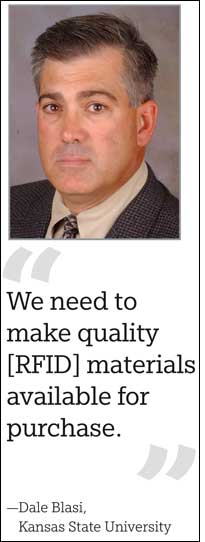Aug 01, 2009Four years ago, an extortionist claimed to have fed hay tainted with foot-and-mouth disease—which is highly contagious among cloven-hoofed animals—to livestock on an island off the coast of Auckland, New Zealand. Exports of beef, mutton, wool, cheese and other farm products are a pillar of New Zealand's national economy, so the country had to test tens of thousands of sheep, cattle and other livestock, as well as alert international trading partners about the threat.
The scare proved to be a hoax. No sign of foot-and-mouth disease has ever been found in New Zealand. But it drove home a point to government and industry about the need for more effective protection of animal health, the food supply and the export trade. Today, the South Seas nation is poised to join the growing ranks of governments that are mandating the use of radio frequency identification technology to better identify livestock and track the animals through the value chain.
"It was a damn good exercise that highlighted a lot of problems we would have had if that had been real," says Ian Corney, chairman of New Zealand's National Animal Identification and Tracing (NAIT) project, an industry and government consortium formed in the wake of the scare. NAIT recently concluded RFID pilots on a series of saleyards and meat processors, and is preparing a business case in support of a government-backed RFID program that would go into effect in 2011 for the mandatory tagging of cattle and deer. "What we have at the present moment is just a herd-based or mob-based identification system. When it comes to actually tracking individual animals, it becomes very difficult because it's all based on a paper trail," he says.
For thousands of years, animals have been branded, tattooed or identified with numbered ear tags. At first, this was to delineate ownership of valuable animals, but after outbreaks of livestock diseases in Europe during the 18th century, some governments started requiring owners to keep paper certificates attesting to the origin of the animals and their health. More recently, there has been a push to move from a paper-based or bar-code tracking system to RFID, which is more automated and less prone to human error than manually reading plastic ear tags or trying to scan bar codes that may be covered with mud. This push for RFID has been prompted by growing concerns about food safety worldwide, whether due to potential bioterrorist attacks or the need to contain livestock epidemics, most notably bovine spongiform encephalopathy (BSE), also known as mad cow disease.
The adoption of RFID to track and trace livestock "from the farm to the fork" is expected to widen rapidly due to government encouragement and, in some cases, mandates. IDTechEx, a research and analysis firm, forecasts that the $462 million spent worldwide on RFID for livestock and farming in 2007 will rise to $2.6 billion by 2017. Certain countries, including Australia and Canada, now mandate the use of RFID to track cattle. The United States and some other countries are asking farmers to voluntarily participate in track-and-trace programs without specifying the type of identification technology that should be used. But voluntary programs tend to have less-than-stellar participation rates.
Farmers are more likely to participate in track-and-trace programs if they can realize business benefits from RFID-tagging their herds. Some farmers not affected by mandates are already deploying RFID to help improve farm management, achieving labor and cost savings. In Canada and other countries, industry groups are trying to foster the exchange of RFID-generated data between farmers and meat packers to increase insight into breeding, health and feed choices.
After a BSE outbreak in the United Kingdom starting in the 1980s resulted in more than 177,000 confirmed cases among 35,000-plus herds of cattle, governments around the world responded with measures to protect their food sources, export trade and animal health. The potential international impact was frightening. And since then, globalization has increased the sale of animals and animal products across borders—international trade in meats has risen by 300 percent in the past 15 years alone—but that has also increased the difficulty in tracking items in the event that disease is discovered or products are recalled.
"In light of some of the diseases that are carried by livestock in different parts of the world, with food products being transported across boundaries, a lot of regulatory agencies within these countries—including the U.S.—are very concerned about not having enough information about the visibility and the movement of livestock," says Paul Chang, who leads IBM's business strategy for emerging technologies. Currently, there is no system to identify and locate precisely where meats come from, down to the individual animal. RFID is becoming attractive to some lawmakers because it can provide a record of when the animal was born, where it was raised, and what animals it came in contact with during its lifetime. "It's kind of like the drug pedigrees being required now in the U.S.," Chang says.
Some countries, including Australia and New Zealand, require the use of RFID to track certain types of livestock, to protect both consumers and the countries' export of meat and other animal products. With Canada's launch of an RFID mandate for cattle, it ordered that the previous bar-code system be phased out by the end of this year and that all cattle leaving their farm of origin be fitted with RFID tags instead. The unique identification numbers on those tags are linked in a database with the movements of each animal until its slaughter or export.
Other nations have instituted mandatory livestock tracking without specifying a technology. In 1998, the U.K. launched a computerized cattle-tracking system that requires ear tags to be attached to all bovine animals within three weeks of birth. Farmers can opt to attach RFID tags to their animals, but at their own discretion. Argentina and Brazil have instituted similar mandatory identification and tracking programs for cattle without specifying technologies, but Brazil's program wasn't sufficient to satisfy European regulations for beef imports, which has cost that country millions of dollars.
In the United States, RFID tracking of cattle has been made mandatory in only one state—Michigan—and that was prompted by the need to keep bovine tuberculosis under control. A voluntary livestock-tracking program, the National Animal Identification System (NAIS), is administered nationwide by the U.S. Department of Agriculture (USDA). The program does not require participants to employ RFID technology, though it does make recommendations regarding specific RFID standards and ID numbers. Wisconsin offers livestock producers an incentive program for purchasing USDA-approved RFID tags.
The NAIS program, however, has suffered from a lack of participation: Only 520,000 farms and other livestock premises are registered, representing about 36 percent of the total, according to a USDA spokesperson. The lack of participation is due, in part, to privacy and confidentiality concerns; farmers don't want to give the government too much information about their business, such as how much livestock they keep or whom they sell it to. But there is also reluctance to get involved in the NAIS program because of the cost of investing in RFID technology, especially for small farms. In addition, several states are considering restrictions on the use of RFID, and some leading food and agricultural groups claim the program is "fundamentally flawed."
Benefits on the Farm
While many farmers are reluctant to participate in national tagging projects, others not under government mandates have chosen to adopt RFID, saying the technology delivers internal business benefits. Unlike ear tags with printed numbers or bar codes, RFID tags can be read without needing a direct line of sight, reducing labor, time and human error. In addition, some farmers have found that by automatically tracking livestock, they can gather important data—from the quantity of milk each cow produces each day to the amount and what type of food each pig eats. This information can help farmers make better decisions about which animals to breed.
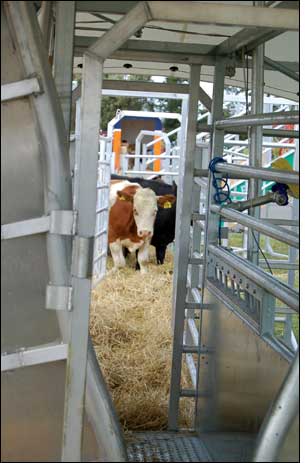
Smithfield Premium Genetics (SPG)—an arm of Smithfield Foods, the largest swine producer in the world—tracks its pigs with RFID ear tags from supplier Destron Fearing. "For every animal we produce, we have an extensive pedigree tree," which helps the company breed superior animals, says William Herring, SPG's technical operations manager. The company also uses RFID to collect feed intake information at individual feeding stations equipped with RFID interrogators that record the identification of the pig, the mix of food it eats, and the amount of that food, by weight, it consumes. "We mine the data to find animals that do things better than others—grow faster or produce more pigs, or grow more efficiently and produce higher-quality meat," Herring says. "The accuracy of that information is very important."
In addition, health records can be tied to an animal's unique identification number through RFID, providing better accuracy for vaccination schedules and treatments than paper-based or bar-code processes and potentially saving money. Dale Blasi, a professor of animal sciences and industry at Kansas State University, has been studying the use of RFID with cattle and has found that human errors can easily be made when animal health records are kept on clipboards, often by farmhands. RFID can also be used to help verify compliance with quality-assurance laws, such as ensuring that animals treated for bovine respiratory disease have completed their round of antibiotics and have undergone a statutory withdrawal period before they can be lawfully harvested at an abattoir, Blasi says.
Some farmers say they expect to realize a return on investment from RFID systems they have deployed and animals they have RFID-tagged. Fetzer Farms, a family-owned 1,700-acre dairy farm in Elmwood, Wis., has been automatically tracking animals by their unique IDs on RFID ear tags since 2008. The farm has also invested in the DeLaval parlour system, which features RFID interrogators at the milking parlour to read each cow's RFID tag and tie it to the weight of milk produced each day. Previously, that information was recorded on paper and then typed into a computer, a time- and labor-consuming process that was prone to human error.
The farm formerly tracked its cattle with neck transponders, but those cost $80 to $90 each, whereas RFID tags cost just $2 to $3 apiece. "We've been very happy with it," says farm manager Paul Fetzer. "We haven't calculated what we've saved, but we're well on our way to seeing a return on investment between labor savings and the cost of buying new transponders, because we just did a herd expansion."
In the future, livestock farmers could derive a host of other benefits from RFID-generated data. SPG is experimenting with using RFID to determine which female pigs reach puberty faster, a genetic trait the farm would like to foster because it means the sow would likely produce offspring sooner, Herring says. To measure this, the farm has rigged up RFID interrogators in a pen for young female pigs that contains one boar. They record how often each female approaches the boar, a sign that she is reaching puberty and ready to breed.
RFID could also help food producers comply with European Union restrictions requiring the labeling and traceability of food and animal-feed products from genetically modified organisms. And livestock producers could employ RFID to create animal pedigrees, assuring consumers that, as advertised, the meat they're buying comes from animals that were organically fed or were not cloned.
Despite the promise of RFID, there are still some challenges to overcome before the technology is used more widely to track livestock—particularly in a country without mandates. In his studies of RFID use with cattle, Blasi has found that some systems are not delivering the read rates and accuracy farmers require to realize gains. "We need to make quality materials available for purchase," he says. "And farmers need to be educated on how to use it." In Wisconsin, a nonprofit industry group called the Wisconsin Livestock Identification Consortium (WLIC) has been set up to educate the state's farmers about RFID and promote use of the technology.
There are also standards issues. While low-frequency (LF) RFID has been specified in some of the government mandates and has become the de facto standard for tracking cattle, debate continues about whether high-frequency (HF) RFID would actually provide farmers with better data gathered at higher speeds. LF tags have to be read one at a time at just inches away, whereas HF tags can be read at higher velocities and at distances of several feet, enabling the quick counting of an entire herd being moved to auction or the slaughterhouse.
While many small farmers around the world are vehemently opposed to RFID-tagging their animals, other farmers believe it's just a matter of time—or maybe an outbreak of disease such as BSE—before more governments mandate the use of RFID to track livestock. "I feel that with the push for national animal identification, sooner or later that's going to be mandatory," Fetzer says. "The consumer is going to push us toward that with concerns about food safety."
In an effort to meet a Canadian initiative to ensure livestock identification and traceability through the food chain, cattle ranchers agreed to identify each animal with bar-code technology starting in 2001. As RFID technology improved and became more cost-effective, the decision was made in 2006 to move from bar-code tags to RFID tags. Each animal's unique ID number and farm of origin is collected in a central database called the Canadian Livestock Tracking System (CLTS). To benefit from tagging their cattle, ranchers wanted information that could help them improve their herds in terms of breeding, feeding and health.
As a result, the Beef InfoXchange System (BIXS), a voluntary national cattle and carcass database, was created by the Canadian Cattlemen's Association (CCA) in partnership with the industry-led, nonprofit Canadian Cattle Identification Agency (CCIA), which administers the CLTS for the government. Software to use BIXS will be rolled out this fall to coincide with the sale of calves to feedlots in September, says CCA general manager Rob McNabb.
BIXS is one of several "value-added" services for the CLTS. During the rollout, information will be collected and added to the database as the calves are RFID-tagged by ranchers and tracked by their unique ID numbers, from the farm through the value chain to the meatpacking plant. The database will include information on where the cattle were born and raised, and their birth dates. The feedlots will add move-in and move-out dates, plus certain performance and animal health records. The cattle should be ready for the packers next year, at which time information on grade or quality of meat from the carcass, the types of cuts, and how much meat was produced will be added.
"It will be pretty basic to start with—the grade and the yield," McNabb says. "But as electronic grading systems advance, the type of measurements a computer-generated grading system can create and provide back will be quite different than it is today. The potential down the road is huge."
Ranchers could, for example, analyze the BIXS data to determine which cattle produced the highest yield and best quality of meat, to help them make better decisions about which animals to breed in the future. The data could also enable them to determine what feed produced the most robust cattle.
In addition, participating in the data exchange will allow ranchers to benchmark and compare their production-management metrics against industry averages. Other advantages include fostering relationships among ranchers, feedlot producers and meat packers/processors. "Imagination is the only limitation for how this information can be used," says Kerry St. Cyr, executive director of the CCIA.

